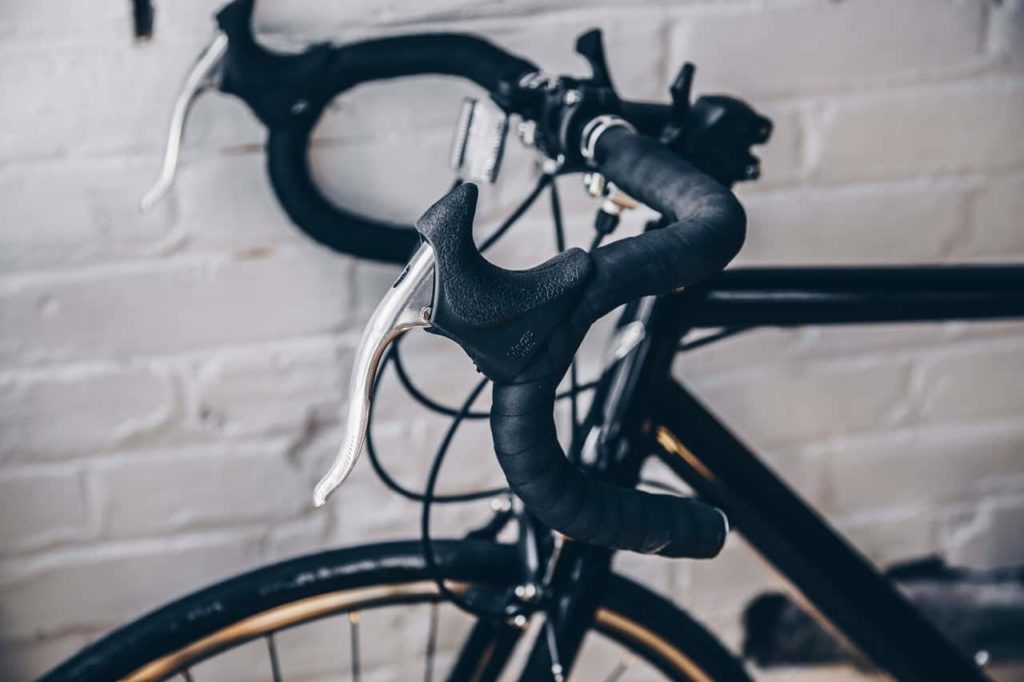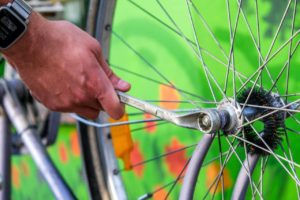The proper bike fit is important for all cyclists, especially those who ride regularly and in longer distances. Being in a comfortable position on the seat, pedals, and handlebars will prevent long-term ergonomic issues. Bike fitting is something you can do yourself, too; just follow these ten rules and you’ll be cycling comfortably in no time!
Rule #1: Make sure you have the proper frame size
Good bike fit starts with the proper frame size. A quick way of figuring this out is to make sure there’s 2.5 to 5 cm (1 to 2 inches) of clearance between the frame’s top tube and your crotch when standing over the bike.
Generally, these guidelines are followed for the height of the rider:
- 5′ 3″ (1.60 m) & under
- Extra Small
- 48-50 cm
- 5’4 to 5’7 (1.63 to 1.71 m)
- Small
- 50-52 cm
- 5’8 to 5’10 (1.72 to 1.79 m)
- Medium
- 54-56 cm
- 5’11 to 6’1 (1.80 to 1.86 m)
- Large
- 58-60 cm
- 6’2 (1.87 m) and over
- Extra Large
- 60- 62 cm
Rule #2: Adjust the seat height

While the frame is a great start, the necessary adjustments are needed to ensure the right fit. Your bike’s saddle – the seat – should be high enough so that your leg on the pedal will be almost fully extended (with a slight bend at the knee) at the lowest point in the downward stroke.
Rule #3: Adjust the seat’s fore/aft position
Once you’ve set the height of the seat, adjust the angle and its fore/aft position on the seat post. Most cyclists should keep the seat parallel to the ground, but some may be more comfortable with the nose slightly angled down. Grab a friend and sit on the seat on a level surface with your pedal at the 3 o’clock position. Use a string with a small weight at the end and dangle it from the small indent immediately below your knee cap. Have your buddy look at the string, and adjust the seat forward or back until they see it intersect the middle of the pedal very closely.
Rule #4: Set the handlebar height
This one’s based more on comfort than a specific technique or formula. The position of the handlebars depends on what performance you want: they should be set above the height of the seat for a more upright and comfortable riding position, or below the height of the seat for a more forwarding-leaning, performance-oriented position. While many hybrid bikes have adjustable stems for changing the height of the handlebars, many bikes do not.
Rule #5: Set the handlebar reach
Place your elbow on your saddle nose and extend your arm and fingers towards the handlebars. The tips of your fingers should touch your handlebars.
Rule #6: Proper foot to pedal for cycling shoes
If you’re wearing cycling shoes, the cleats should accommodate the natural toe in or out of the foot. Position them so that the ball of the foot – the padded portion of the sole between the toes and the arch – is over the pedal spindle. For this, use the bony lump on the inside of your foot at the base of the big toe for reference. Most problems come from the pedal being set too far forward!
Rule #7: Identify the parts you need to be swapped out
Rather than try to force an adjustment, make a note of the components that you can exchange. A new stem – the part that connects the handlebars to the steerer tube of the fork – can change the location of the handlebars for a more comfortable riding position.
Rule #8: The fit should be for your intended usage
How you sit on the bike depends on the power you need to put into it. Riding a road bike requires a different body position than riding a mountain bike, so your fit should be done according to these uses!
Rule #9: Women may need a different fit
Women-specific bikes are designed to accommodate the narrower shoulders and longer leg-to-torso ratio of most women. These rides have narrower handlebars and shorter, more compact frames. However, do what makes you comfortable – some women find that men’s bikes fit well!
Rule #10: Make the adjustments before you ride!
A bad fit can lead to inefficient riding, which can lead to many aches, pains, and strains. Make sure you’re positioned comfortably on your bike before you take a long ride!


